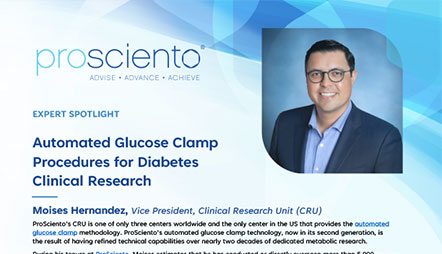About
Expert Spotlight
Moises Hernandez
Vice President, Clinical Research Unit (CRU)
As part of our Expert Spotlight series, we had the opportunity to speak with Moises Hernandez, Vice President of ProSciento’s Clinical Research Unit, about the challenges, benefits, and clinical relevance of glucose clamp studies in diabetes research.
ProSciento’s Clinical Research Unit (CRU) is one of only three centers worldwide, and the only one in the United States, that offers the automated glucose clamp methodology. Now in its second generation, ProSciento’s automated glucose clamp technology reflects nearly two decades of refinement and innovation in metabolic research.
Moises is a recognized expert in metabolic clinical research and one of the leading authorities on glucose clamp methodologies and digital wearable technologies in clinical trials. Over the course of his tenure at ProSciento, he has contributed to more than 300 clinical trials and has conducted or overseen more than 5,000 clamp procedures. His leadership in the design and execution of glucose clamp studies for metabolic drugs and devices has helped establish global benchmarks for accuracy and quality.
You can read the full interview at the link below.



